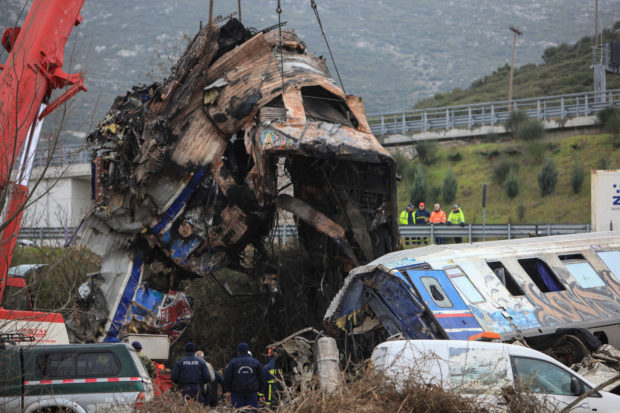
A crane lifts part of a destroyed carriage as rescuers operate on the site of a crash, where two trains collided, near the city of Larissa, Greece, March 2, 2023. REUTERS/Kostas Mantziaris
LARISSA, Greece — Anger and sorrow grew in Greece on Thursday over a devastating train crash that killed dozens of passengers along with crew members near the central city of Larissa in the country’s worst rail disaster.
Carriages were thrown off the tracks, crushed, and engulfed in flames when a high-speed passenger train with more than 350 people on board collided head-on with a freight train on Tuesday, February 28. They were on the same track.
READ: Two trains collide in Greece, at least 32 killed, 85 injured
As more bodies were recovered on Thursday, the number of dead rose to 57, among them university students returning home after a long holiday weekend. Scores were injured.
Outside the hospital in Larissa, where many of the victims were brought, a woman called Katerina, searching for her missing brother, a passenger on the train, screamed: “Murderers! Murderers! I will leave tomorrow with a coffin!”
Katerina, whose anger was directed at the government and the rail company, had, like other relatives looking for loved ones, given a DNA sample to try and identify her brother.
“Pain has turned into anger for the dozens of dead and wounded colleagues and fellow citizens,” the railway workers’ union said. The union launched a strike in protest that ground train services to a halt across the country on Thursday.
READ: Greek rescuers comb through train crash wreckage as hopes fade
Hope of finding survivors amid the charred and buckled rail carriages which rescue workers were scouring through had diminished by Thursday morning.
“The most difficult moment is this one, where instead of saving lives we have to recover bodies,” 40-year old rescuer Konstantinos Imanimidis told Reuters on the site of the crash, about 140 miles (230 km) north of Athens.
“Temperatures of 1,200 degrees and more in the carriages cannot allow for anyone to remain alive.”
Nearby, two brothers were crying, with 33-year-old Sokratis Bozos saying they had come to the site of the crash in the hope of getting some news of their father, after the hospital could not tell them whether his body had been recovered.
Anger
About 2,000 people protested in Athens on Thursday – some holding a banner which read “Our lives matter” – until the crowd was dispersed by heavy rain.
As many in Greece demanded answers, the Larissa station master who was working that evening has admitted to having a share of responsibility in the accident, his lawyer Stefanos Pantzartzidis said outside the courthouse.
“He is literally devastated,” Pantsartzidis told reporters. “Since the first moment, he has assumed responsibility proportionate to him,” he said, while hinting that the station master, whose name has not been made public, was not the only one to blame.
Rescuers carry a body from the site of a crash, where two trains collided, near the city of Larissa, Greece, March 2, 2023. REUTERS/Kostas Mantziaris
Much of the anger has been directed at authorities and the rail companies. On Wednesday evening, protesters hurled rocks at train company offices in Athens. More protests were planned on Thursday.
READ: Disbelief turns to anger as Greeks seek train crash missing
The government said it shared in people’s sorrow and promised to carry out thorough investigations and fix the ailing rail network’s woes.
“We are all devastated by this tragic incident,” government spokesman Giannis Oikonomou told a news conference.
“The loss and trauma this caused, the physical and mental trauma of survivors, and the angst of this country is huge, and its difficult to manage, particularly now.”
He said authorities would look into the causes of the accident, and “chronic delays” in implementing rail projects.
“These delays are rooted in chronic ills of the Greek public (sector), to distortions going back decades,” he said, adding that the government has tried to deal with this but “did not manage to eradicate it.”
READ: Hours after deadly train crash, Greece agonizes over what went wrong
Nikos Tsouridis, a retired train driver trainer, said human error did not fully explain what happened.
“The station master made a mistake, he acknowledged it, but surely there should be a safety mechanism to fall back on,” he said.
Greece sold railway operator TRAINOSE under its international bailout program in 2017 to Italy’s Ferrovie dello Stato Italiane, expecting hundreds of millions of euros to be invested in rail infrastructure in the coming years.
The Italian operation has responsibility for passenger and freight, and the Greek state-controlled OSE for infrastructure.